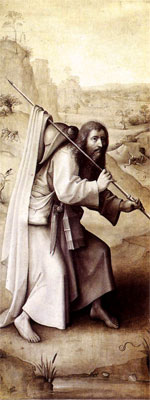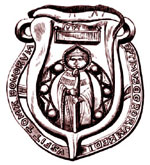Medieval Pilgrims
The Medieval pilgrims had a significant role in the society. Through their international travels they facilitated the exchange of culture and habits across nations. Even the important Military Orders were created in close relationship with the pilgrims.
The pilgrimage was an important component of life in the Middle Ages. Many hospitals were founded at places of pilgrimage and along the high roads, in order to offer care to poor pilgrims and travelers.
Medieval pilgrims and the Military Orders
The fashion of going on pilgrimage seems to have sprung up in the fourth century. The first object of pilgrimage was the Holy Land. Thousands of people went to see with their own eyes the places which had been hallowed by the presence and the deeds of their Lord.
The Knights of St. John or the Knights Hospitaller were founded by the Italian merchants of Amalfi, for the purpose of providing hospitality to pilgrims in the Holy Land, their chief house, called the Hospital, being in Jerusalem. They had independent hospitals in other places, which were also frequented by the pilgrims.
The order of the Knights Templar was a fraternity which embraced the fundamental monastic vows of obedience, poverty, and chastity. They undertook the task of escorting the companies of people on pilgrimage to the Holy Places, all the way from the coast up to Jerusalem.

St. James as a Pilgrim
"The Last Judgment"
by Hieronymus Bosch
Medieval pilgrimage sites
The main foreign pilgrimages were to the Holy Land, the scene of Jesus’s earthly life, to Rome, the centre of Western Christianity, and to the shrine of St. James at Compostela.
The Roman pilgrimage ranked next to that of the Holy Land, as Rome was the great centre of the religion of Western Christendom. The plenary indulgence which Boniface VIII published in 1300 to all who will make the Jubilee pilgrimage to Rome, contributed in popularizing this destination. During the Jubilee, in a single month, over two hundred thousand pilgrims visited Rome.
Those who could not afford to go to Jerusalem, or to Santiago de Compostela, went on pilgrimages to English shrines.
The most popular of the English pilgrimages was to the shrine of St. Thomas Becket at Canterbury, which was also known all over Europe. Judging by the number of participants, the second in importance was the pilgrimage to Our Lady of Walsingham. England had many cathedrals, great monasteries, and parish churches whose saints made them sites of pilgrimage. Among others, there was St. William at York, St. Edward the Confessor at Westminster, St. Wulstan at Worcester, and St. Edmund at Bury.
Preparing the pilgrimageBefore the Medieval pilgrim started his journey, he first went to his priest to receive the Church’s blessing, and to pray for a safe return. The office of pilgrims can be found in old service books. The pilgrim who was sent in pilgrimage as a penance was usually ordered to go barefoot, although there were a lot of people doing the same voluntarily in order to heighten their merits. Often, people participating in a pilgrimage made the vow to not cut their hair or beards until their mission was accomplished.
Medieval pilgrims' badges
The characteristic insignia of a pilgrim were the staff and scrip. The staff was similar to a walking-stick, having a natural knob at the top. The staff could be up to seven feet long, with two knobs, one on top, the other one about a foot lower. Under the later, sometimes there was a hook used for carrying a bottle of water or a small bundle. The scrip was similar to a pouch, and was used to carry some of the pilgrim’s belongings.
Besides these general signs, every pilgrimage had its distinct badge, which the pilgrims wore on their return, often round the neck, as a proof of their accomplishment. A pilgrim to the Holy Land wore the signs of this pilgrimage above any other. It was a cross sewn upon the shoulder, the English pilgrims having a white cross, while the French had a red one.
The pilgrim to Rome was entitled to wear badges representing all the shrines he had visited in the great capital. The characteristic signs of the Roman pilgrimage were a badge with the effigies of St. Peter and St. Paul, the cross-keys, and the vernicle. The arch-priest and canons of St. Peter’s in Rome, had the right (granted to them by Innocent III) to cast and to sell the lead or pewter signs, bearing the effigies of the Apostles Peter and Paul, which were worn by those visiting the places as proof of their devotion and their pilgrimage.
The badge of the pilgrims to Santiago de Compostela was the scallop shell, the traditional emblem of St. James, while the chief sign of the Canterbury pilgrimage was the ampulla, a flask.

Canterbury Pilgrims' Badge
The character of the Medieval pilgrimages
The pilgrimages were very popular as they were not only intended to obtain spiritual pardons and immunities at the shrines of the saints, but also to make the journey to those places a very pleasant holiday excursion.
There were many pilgrims who undertook the pilgrimage in anything but a holiday spirit, many submitting to the privations of mendicant pilgrimage. However, it appears that this was not the general character of the best known pilgrimages, and in the majority of cases they also had the character of a pleasant religious holiday.
The time of a Medieval pilgrimage was often spring, as mentioned by Chaucer whose pilgrims started in April. It was the custom for the Middle Ages pilgrims to associate in companies, as they travelled the same roads, about the same time of year, and stopped at the same inns and hospitals. Everybody was trying to make the journey agreeable to one another.
When the pilgrim had returned safely home, he presented himself in Church to thank for the accomplishment of the pilgrimage and his safe return. The following days were spent visiting relatives and friends who congratulated him on his return. Some Medieval pilgrims presented their staffs and scrips to their parish churches.
